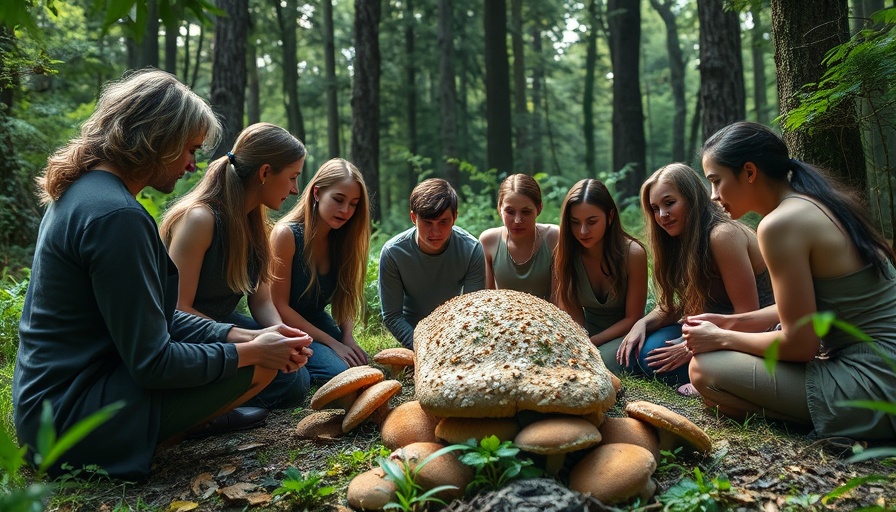
Revolutionizing Death: The Rise of Sustainable Burials
In a groundbreaking move, the first-ever mushroom casket burial in North America took place in Industry, Maine on June 1, 2025, marking a significant milestone in eco-conscious end-of-life traditions. This event carries profound implications for both environmental sustainability and cultural attitudes toward funerary practices. The mushroom casket, created from mycelium—the root structure of mushrooms—biodegrades within just 45 days, allowing individuals to nourish the soil rather than contribute to its depletion.
Why It Matters: Environmental Impact of Traditional Burials
Conventional burials in the U.S. involve significant environmental costs, using approximately 20 million board feet of wood, 4.3 million gallons of embalming fluid, and substantial amounts of concrete. These practices contribute to deforestation, chemical pollution, and an overall environmental footprint that is hard to justify in an age of rising climate awareness. The shift towards green burials, increasingly documented by the Green Burial Council with a 72 percent rise in sustainable cemetery options, illustrates a growing demand for responsible end-of-life choices.
A Personal Touch: Mark C. Ancker's Final Wish
The Ancker family’s decision to use a mushroom casket was deeply personal. Marsya Ancker decided on this innovative burial method to honor her father's wish of returning to the land he loved. This choice not only fulfilled a heartfelt commitment but also aligned with a larger trend of honoring loved ones while protecting the environment.
“He wanted his final resting place to nourish the land and plants he cherished,” said Marsya,
highlighting the intimate connection between one's final resting place and their lifetime values.
Green Burials: A Broader Trend Towards Sustainability
The Netherlands-based Loop Biotech has pioneered the mushroom casket concept, facilitating over 2,500 similar burials across Europe since 2021. Their vision, as articulated by founder Bob Hendrikx, is transformative:
“Funerals can be more than endings; they can be beginnings.”
This sentiment encapsulates the emerging ethos surrounding death and sustainability. Products like the Loop Living Cocoon not only provide a biodegradable alternative but also invite communities to reclaim agency over how they manage their mortal remains.
Counterarguments and Diverse Perspectives on Green Burials
While the movement towards green burials garners support, it also faces skepticism. Critics may question the scalability of such practices. Can eco-friendly caskets effectively replace conventional methods? However, the growth of organizations like the Global Green Burial Alliance, founded in 2022 to foster connections between service providers and consumers, suggests that many are eager for solutions that bridge personal and ecological responsibilities. The green burial movement is more than a trend; it is a potential paradigm shift.
Practices for Eco-Conscious Funeral Homess
For funeral homes, integrating sustainable practices into their operations can resonate deeply with environmentally conscious people. Implementing practices such as chaos gardening—where loved ones can participate in reshaping landscapes sustainably—can elevate family experiences while promoting local biodiversity. Additionally, incorporating materials that reflect eco-awareness, such as mushroom casket and leather alternatives, can also engage people in conversations about sustainability.
Fostering Climate Awareness Beyond Travel
As awareness of climate issues and protective measures grows, embracing eco-friendly funerary practices could influence broader behaviors. Shifting narratives around death and sustainability can inspire communal responsibility toward protecting our planet.
As we witness the introduction of mushroom casket burials into North America’s cultural fabric, it sparks a larger conversation on how we can honor our loved ones while being stewards of the environment. The implications of this shift are profound; as individuals embrace these practices, they contribute to a narrative of sustainability that extends far beyond life itself. By choosing to enrich rather than deplete, we may start to redefine the meaning of a life well-lived.
As we confront the realities of climate change and environmental degradation, the choices we make—both in life and in death—can reflect our commitment to a sustainable future. Embrace conversations around these innovative practices in your own hospitality offerings and let them drive deeper connections to nature and people.
 Add Row
Add Row  Add
Add 




Write A Comment